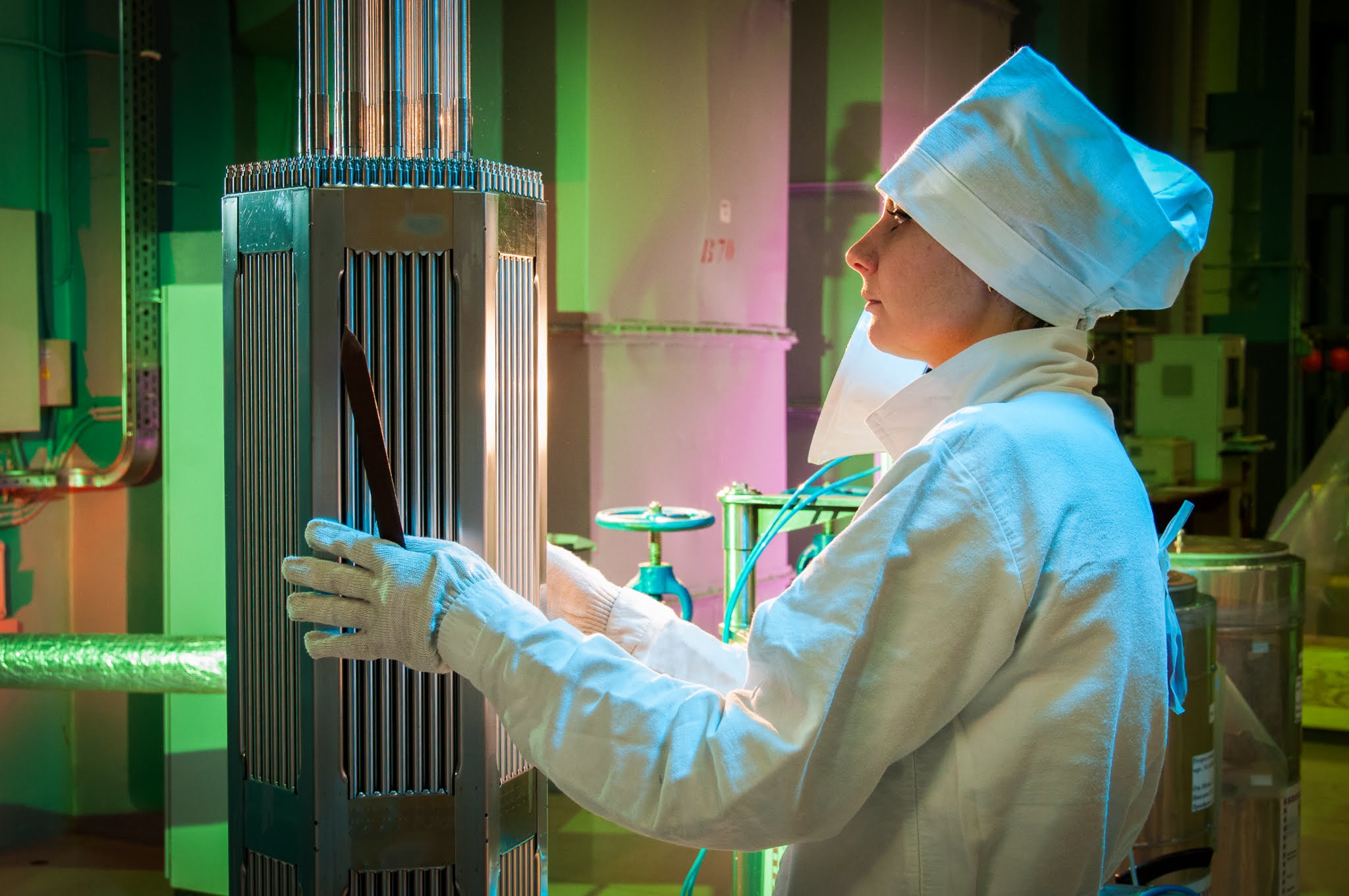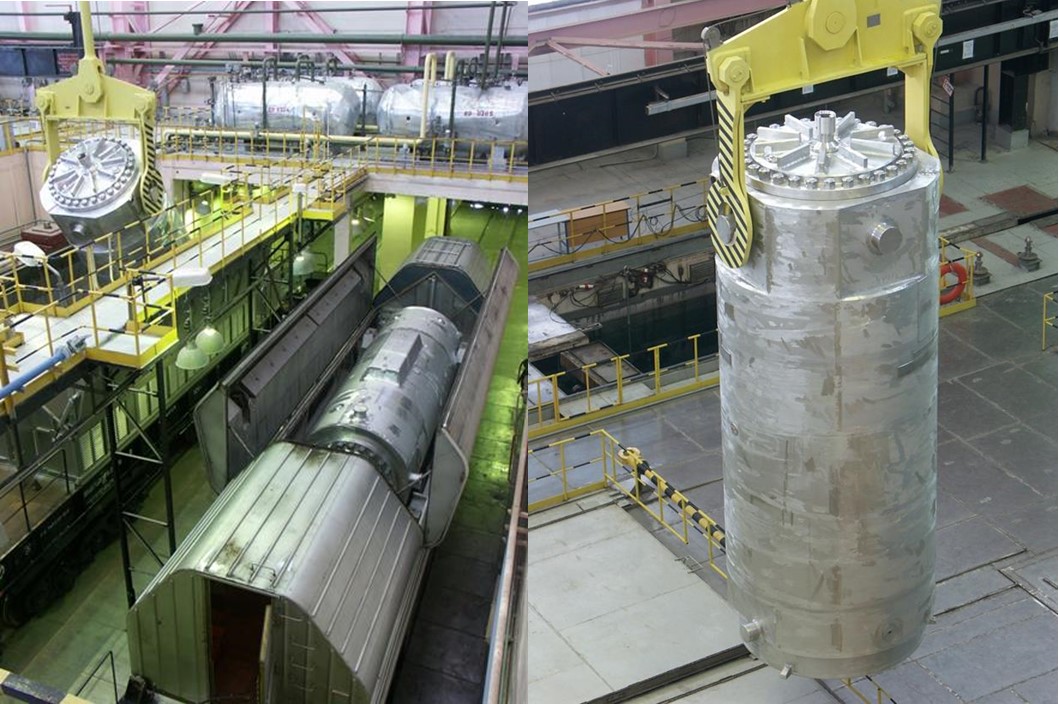
Photos of cars with spent nuclear fuel at the Tyumen station. Photo: Tyumen BC / Vk.cm
Let's start with the basics. Nuclear power plants use uranium as fuel. But in what form is it used there and how does it get there? Uranium is mined, then enriched in the required isotope - uranium-235. Then they are brought into the desired chemical form - the form of uranium dioxide.
The uranium dioxide powder is then sintered into ceramic tablets of about 4.5 grams each. The pellets are collected in fuel elements - fuel rods. Fuel elements are assembled into fuel assemblies of fuel assemblies, or fuel assemblies. And already these cassettes are loaded into the reactor.
There are 163 fuel assemblies in a typical VVER-1000 reactor.
Approximately once a year, 20% of the fuel is unloaded from the reactor and replaced with fresh one. So each such cassette works in the reactor for about 5 years on average. Thus, about 15-20 tons of fuel are unloaded from the reactor per year. And for their transportation, you need just about the very same 4 cars that were found in Tyumen.
During operation in the reactor, a small part of uranium, only a few percent, burns in the fuel. Well, it doesn’t literally burn, it’s just such a term, by analogy with conventional fossil fuel power plants. Earlier, even a nuclear reactor was called a boiler by analogy. In reality, part of the uranium simply decays as a result of a chain reaction of fission, and from it the so-called fission fragments are formed - new lighter elements. Mostly radioactive.
As a result of other reactions, a part of new heavy atoms appears in the fuel, the so-called minor actinides - americium, neptunium, curium. All of these new elements worsen the properties of the fuel and can be classified as radioactive waste. Although, if desired, they can also be selected and used.
The other part of the fuel, and this is more than 90% of its mass, is the remaining uranium, mainly the isotope 238, which did not participate in nuclear reactions. And then there is a new element, plutonium. This uranium and plutonium, if desired and available, can be reused as fuel. It turns out, as in the story about a barrel of honey (fuel) and a fly in the ointment (waste).
Moreover, this fly in the ointment, i.e. waste, significantly changes the properties of the fuel, making it highly radiotoxic.
If fresh nuclear fuel can be picked up and stood next to it without any serious protection except a dressing gown and gloves (he touched it this way at a plant in Novosibirsk), then spent fuel, due to accumulated gamma emitters, creates such radiation power that the person next to him will receive a lethal dose in a few minutes. But fortunately, you can't just approach him. All SNF operations are carried out remotely, inside pools with water that protects against radiation.

Inspection of fresh nuclear fuel. A source.
But what about the spent fuel? There are two global strategic approaches, and different countries where there is nuclear power, adhere to either one or the other. Somewhere it is believed that nothing needs to be done with SNF, no need to get dirty, you just need to dispose of it in the form in which it is taken out of the reactors, entirely.
Somewhere, for example, in Russia, France, Great Britain, Japan, it is believed that tar can be separated from honey in this barrel. These countries have the technology to recycle spent fuel. This recycling allows valuable components to be extracted and reused, thus saving natural resources. It also makes it possible to reduce the volume of waste to be buried by hundreds of times. After all, now the withdrawal is not the whole barrel of honey, but only that very fly in the ointment. Moreover, the life of this waste can be reduced thousands of times, up to hundreds of years, if loaded into special nuclear reactors.
So, in Russia, as in some other countries, there are plants for the reprocessing of spent fuel. Historically, this is done at the Mayak PO in Ozersk, in the Chelyabinsk region. It's just that the process is very similar to the process of obtaining plutonium for nuclear weapons, for which the plant was built in Soviet times. But not all nuclear power plant fuel is processed at Mayak. Its main volumes from the most common reactors have not been processed in Russia until now, but accumulated.
Now Rosatom is implementing a concept according to which fuel from nuclear power plants is taken to a centralized storage facility at the Mining and Chemical Combine in the city of Zheleznogorsk, Krasnoyarsk Territory. This plant, like the Mayak, was created during the Soviet atomic project in one of ten closed atomic cities built in due time to create atomic weapons.
Ok, we understand where they are taking them, but from where?
Judging by the pictures from Tyumen, in the photo there are wagons and containers for transporting fuel from VVER-1000 reactors. This is the most common type of reactor for nuclear power plants in Russia and the post-Soviet space. And in the world such pressurized water reactors are the most widespread. In Russia, VVER-1000s operate at 4 out of 11 nuclear power plants. They work at Balakovskaya, Kalininskaya, Novovoronezhskaya and Rostov nuclear power plants.
Now it is clear how the containers ended up in Tyumen - on their way from nuclear power plants in western Russia to storage and future processing points in the East, in Siberia. We just have one main line across the country - the Transsib. They travel along it through Tyumen and my native Yekaterinburg.
Are such transportation dangerous?
Despite the fact that the spent fuel itself is very radioactive, appropriate safety measures are taken to transport it. First, after the fuel is unloaded from the reactor, it is stored at the station for several more years in a special cooling pool. There, due to the decay of short-lived isotopes, its activity is significantly reduced. For example, in the first year, it falls a hundred times. This means that the background from this fuel and its heat release also decrease. Yes, even years after being unloaded from the reactor, the fuel continues to warm up.
After such exposure, the spent nuclear fuel can already be sent to storage or for reprocessing. For the transportation of such dangerous goods, special protective transport and packaging kits (TUK) have been developed from special wagons and containers. This is not just a metal tank, it is a complex, multi-layer, composite structure with control sensors, with a total weight of over 100 tons. TUK-13 for transportation of VVER-1000 fuel can accommodate up to 12 fuel assemblies or up to 6 tons of fuel. And next to such a container, you can already stand calmly, without risking a dangerous dose. It blocks both gamma and neutron radiation.

Car-transporter and container TUK-13 for transportation of VVER-1000 reactor fuel. Photo - portal ftp-yarb2030.rf
But it's not just about radiation protection. Such containers are designed so that even in the event of an accident, they will not lose their tightness, which means that hazardous substances will not get out. Containers are designed and tested to withstand falls onto concrete, collisions with obstacles, fires and immersion in water.
You can look at video frames of foreign tests and demonstrations of the properties of such containers:
Or for Russian trials (from 0:50):
So the transportation of such goods by the Transsib does not pose a threat. It is not easy to steal a 100-ton container, it will not work to open without special equipment and conditions, it is useless to derail and even blow up, it is designed for this.
I want to end with two conclusions. Good and bad.
I'll start with the good. Let me remind you of the figure of 20 tons of fuel that nuclear power plants need every year for operation. This is enough to supply electricity and partly with heat to a whole million-plus city like Yekaterinburg for a whole year. For a coal plant of the same capacity, not 20, but several million tons of fuel will be needed. Part of it, when burned, will literally fly out into the pipe and settle in our lungs, and then add CO2 to the atmosphere with all the ensuing consequences for global climate change. And these millions of tons must be transported, along the same railway, through the same cities ... So it’s probably better to transport 4 railroad cars with nuclear fuel once a year - it’s safer.
And the bad conclusion is that, despite all the security measures for the transport of radioactive materials and nuclear fuel, the risks of transport accidents remain. But they are connected more with other things. In Russia, up to 800 million tons of dangerous goods are transported per year - explosive, flammable and toxic substances. And to put it mildly, not all of them are transported in such durable containers as radioactive materials. Therefore, it is necessary to improve the safety of all transportation, build bypass routes for freight trains around large cities, and in general invest in infrastructure, as well as in science, technology, education and other important public institutions. Then people will be less afraid of various horror stories, including nuclear ones, and all of us will live easier and more comfortable.
Video bonus.
On this topic, I recorded a video for my youtube channel , where there are a little more visual materials. Look, subscribe, like, then I will probably do more such videos and articles:
References to used sources and materials for independent study:
1. Development of a cluster for SNF management at FSUE "MCC"
2. TRANSPORTATION OF RADIOACTIVE MATERIALS. Bellona's report
3. Spent nuclear fuel from thermal reactors
4. Review of problems of radioactive waste management. Sarov.
5. CONTAINERS FOR SPENT NUCLEAR FUEL. Pines.
6. OJSC Atomenergomash's Opportunities in Spent Nuclear Fuel and RW Management Moscow October 2013 VII International Forum AtomEco 2013
7.The Program for the Development of Container Technologies for the Management of SFAs of Russian NPPs as a Tool for the Unification of Solutions for the Long-Term Storage of SNF Makarchuk M.Yu. Afonyutin JSC FCNRS. ATOMEXPO-2015 01-03 June 2015
8. Design of packing sets and containers for SNF transportation.
9. Radioactive components of NPP: handling, processing, containment